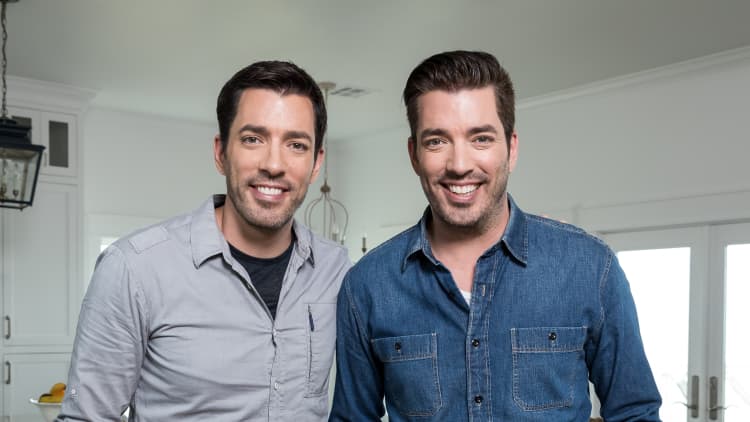
Despite the coroanvirus pandemic, home sales are up.
If you were thinking of taking advantage of low mortgage rates yourself, first make sure you know what you can afford.
"When we first decide to purchase a home, we get really excited about that ideal home," said Winnie Sun, co-founder and managing director of Irvine, California-based Sun Group Wealth Partners and a member of the CNBC Financial Advisor Council.
"But what you want to do is also reel back and sort of start [with] the basics and figure out how much home you can realistically afford," she added. "Not just today, but also in the future."
Initial costs include a down payment, closing costs and moving fees. Yet there are also other factors to consider, such as how much it will cost you to start up and maintain your home.
Where you buy the home also matters — some areas are pricier than others.
However, the National Association of Realtors found that the starter median home price in U.S. metro areas was $233,400 in the first quarter of 2020. If you have a down payment of 20%, you'll have to come up with $46,680. If you put down 10%, you'll need $23,340 and a 3% down payment is $7,002.
Here's what to look out for when buying your first home.
Mortgage rates
Record-low mortgage rates are certainly enticing buyers into the market. The average 30-year fixed mortgage rate is 3.150%, according to Bankrate.
However, that doesn't necessarily mean you are going to get that rate. Banks take into account your credit score, the type of loan and how much you put down. It also depends on the lender; some may offer lower rates than others.
"We are looking at pretty high credit-worthy people, on average, when we report those numbers," said Skylar Olsen, Zillow's senior principal economist.
"It is a 20% down-payment rate we are talking about."
There are different types of loans, like conventional mortgages with a 30-year or 15-year fixed rate. Adjustable rate mortgages, or ARMS, may offer a lower initial rate. With an adjustable rate loan, after a fixed time period, the rate goes up.
Start [with] the basics and figure out how much home you can realistically afford. Not just today, but also in the future."Winne SunSun Group Wealth Partners co-founder
There are also FHA loans, which offer low down payments and closing costs and are guaranteed by the federal government. They also come with an upfront premium of 1.75% of the purchase price of the home. For a $233,400 home, that means you'll pay a mortgage insurance premium of $4,084.50. You'll also pay monthly insurance premiums, which depends on your loan amount, the term of your mortgage and your loan-to-ratio value. It ranges from 0.45% to 1.05% of the loan amount.
Service members and veterans can apply for a VA home loan and a down payment or private mortgage insurance often isn't required. The current rate for a 30-year fixed loan is 3.150%, according to Bankrate.
Shop around for the best interest rate and fees and then get pre-approved for a mortgage.
Down payment
This is the part of the sales price that you pay out of pocket. You finance the rest with your mortgage.
While a 20% down payment may seem hefty, there is one big advantage to it: Anything less is subject to primary mortgage insurance, or PMI.
That cost is added into your mortgage payment and "is going to make your effective interest rate higher," Olsen said.

The cost of PMI varies but generally the premiums can range from $30 to 70 per month for every $100,000 borrowed, according to Zillow.
However, don't tap into your emergency savings for your down payment, warned certified financial planner Sophia Bera, CEO and founder of Gen Y Planning, based in Austin, Texas.
"It is still really important to have at least three months of net pay saved for emergencies," said Bera, a member of the CNBC Financial Advisor Council.
Closing costs
There are countless fees involved in buying a home, which are generally wrapped up into what's referred to as closing costs.
They include things like an application fee, bank appraisal of the home's value, attorney fee, escrow fee, credit report, homeowners insurance, title insurance, loan origination fees, transfer taxes, title search fee and recording fees.
It all totals up to between 2% and 5% of the home price and is due at the time you close on the house.
More from Invest in You:
Refinancing your mortgage could put cash in your pocket
Suze Orman: A perfect financial storm is brewing and it is worse than 2008
How to decide if you should tap into your retirement savings
So, for a $233,400 home, expect to shell out between $4,668 and $11,670 in closing costs.
A home inspection may also be included in your closing costs, or you may pay for it ahead of time. While the costs vary, it typically ranges between $300 to $500, according to the U.S. Department of Housing and Urban Development.
Again, shop around to see what lenders can offer you lower fees for closing. Bera suggests looking at your local credit union, if you are a member.
"Sometimes credit unions have some of the best rates and closing cost deals," she said.
Moving costs
Once the house is yours, it's time to move your belongings in. You can enlist some friends to fill up a rented truck if you are trying to save money. Or, you'll have to hire a moving company.
If you are moving locally, it will cost you an average $1,250, according to Moving.com. The average cost of a long-distance move is $4,890 for a distance of 1,000 miles, the site found.
Maintenance fund
The first year, your house is probably going to need a little love. You may want to paint, make some cosmetic changes and buy furniture.
Bera suggests putting $5,000 to $10,000 into a home maintenance fund to cover those initial costs.
Moving forward, you should also put some money aside every year for repairs and maintenance to the house so when something happens, like a leaky roof, it doesn't bust your budget.
Save anywhere from 1% to 4% of your home's value a year for those maintenance and repairs, Olsen said. The amount depends on the age of the home, since older homes may need more work and newer homes may not.
Other 'hidden' costs
Once you own the home, you'll have to pay property taxes to your local government. It's based on the assessed value of your property and your town's tax rate.
It also varies dramatically from state to state. According to a Wallet Hub analysis, Hawaii has the lowest rate with residents paying $560 in annual taxes on a $205,000 home. New Jersey has the highest rate, with homeowners shelling out $5,064 for a house of the same price. The average homeowner spends $2,375 a year on property taxes, the report states.
Plus, there will be future tax increases, Olsen points out. As your home appreciates, and your home is re-evaluated by the tax assessor's office, your taxes will rise. The coronavirus pandemic has also left municipalities cash-strapped, since sales tax and income revenues down, she said. That could me a possible tax hike down the road.

You may also have to pay a homeowners association (HOA) fee if your property is part of a homeowners association. The funds help cover maintenance and repairs in the public areas. The fees widely vary but can run you around $200 or $300 per month, according to Realtor.com.
There is also homeowners insurance, which costs typical homeowners slightly less than $1,000 a year, and utility costs, which average almost $3,000 annually, according to a 2017 Zillow report by Olsen on the hidden costs of homeownership.
Lastly, optional services may also add up, if you so chose. That can include lawn maintenance, gutter cleaning, and Heating, ventilation, and air conditioning maintenance.
In all, those hidden costs can end up costing U.S. homeowners $9,080 a year, the report found.
SIGN UP: Money 101 is an 8-week learning course to financial freedom, delivered weekly to your inbox.
CHECK OUT: If you invested $500 in 2010 according to Warren Buffett's advice, here's how much you'd have now via Grow with Acorns+CNBC.
Disclosure: NBCUniversal and Comcast Ventures are investors in Acorns.






